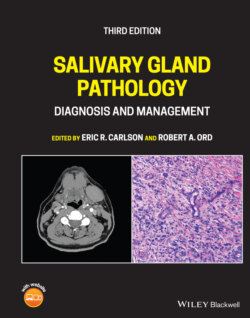Читать книгу Salivary Gland Pathology - Группа авторов - Страница 101
NEOPLASMS – NON‐SALIVARY Benign Lipoma
ОглавлениеIn the cervical soft tissues, lipomas are slightly more commonly seen within the parotid gland rather than periparotid. Lipomas of the salivary glands are uncommon (Shah 2002). The CT and MRI characteristics are those of subcutaneous fat with CT density very low (approximately 100 H) and hyperintense on both T1 and T2. Lipomas tend to be echogenic on US. They may be uniform on imaging but may have areas of fibrosis. The heterogenous density from fibrosis, or hemorrhage, carries the additional differential diagnosis of liposarcoma or other neoplasms (Som et al. 1995), (Figures 2.72 and 2.73).
Figure 2.70. Reformatted contrast‐enhanced coronal CT with a mass in the right submandibular gland (arrow) diagnosed as an adenoid cystic carcinoma.
Figure 2.71. Reformatted sagittal contrast‐enhanced CT corresponding to the case illustrated in Figure 2.65.
Figure 2.72. Axial contrasted‐enhanced CT of the head with a fat density mass at the level of the parotid gland and extending to the submandibular gland, diagnosed as a lipoma.
Figure 2.73. Axial contrast‐enhanced CT through the submandibular gland with fat density mass partially surrounding the gland. A lipoma was diagnosed.
